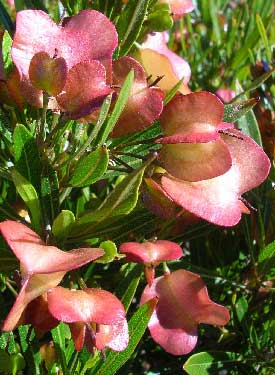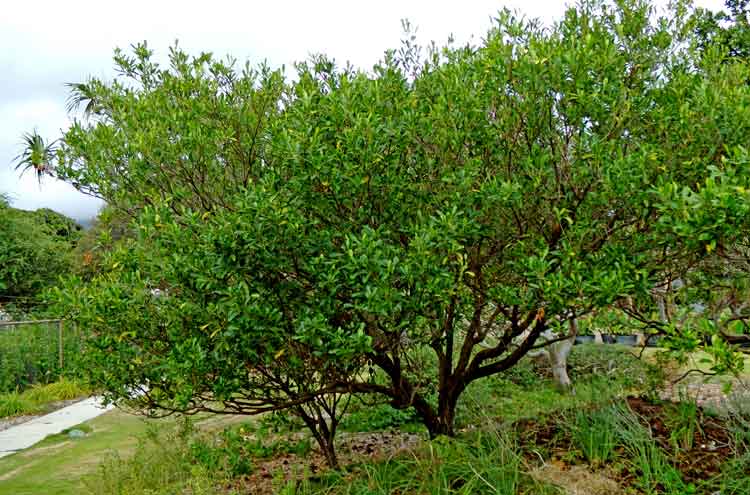‘A‘ali‘i (Dodonaea viscosa)
Hawaiian Name: ‘A‘ali‘i
Scientific Name: Dodonaea viscosa
Family: Sapindaceae (Lychee Family)
Status: Indigenous
Where found: All main islands
Water/Light: Dry, with full to part sun exposure
Elevation range: 10 to 7,710 feet
Height: 6 to 26 feet
‘Ōlelo Noeau [M. K. PUKUI]: He ‘a‘ali‘i ku makani mai au; ‘a‘ohe makani nana e kula‘i.
Translation: I am a wind-resting ‘a‘ali‘i; no gale can push me over.
Meaning: A boast saying, "I can hold my own, even in the face of difficulties." The ‘a‘ali‘i can stand the worst of gales, twisting and bending but seldom breaking off or falling over.


Notes: In old Hawai‘i, the durable wood of ‘a‘ali‘i was used to make house posts, canoes and spears. The fruits can be boiled to make a red kapa dye, and the flowers continue to be used to make beautiful lei. Medicinally, ‘a‘ali‘i leaves were mixed with other plants in a remedy to treat skin rashes (‘ohune or mane‘o). Prune sparingly, as ‘a‘ali‘i does not heal well when major branches are cut. This native is drought, salt and wind resistant, and highly adaptable. The seed capsules are used in haku lei. Plants are either male, female, or both. It is best to prune sparingly and early. ‘A‘ali‘i has an attractive form and is extremely drought tolerant.
*Photo courtesy of Forest & Kim Starr
A Few Native Hawaiian Plants from the MNBG Collection
- ‘A‘ali‘i (Dodonaea viscosa)
- Alahe'e (Psydrax odorata)
- ‘Ānapanapa (Colubrina asiatica)
- Hala (Pandanus tectorius)
- Hala pepe (Dracaena auwahiensis)
- Hau (Hibiscus tileaceus)
- Hō‘awa (Pittosporum glabrum)
- Hō‘awa (Pittosporum hosmeri)
- ‘Iliahi (Santalum haleakalae)
- ʻIlima papa (Sida fallax)
- Kalo (Taro), Colocasia esculenta)
- Kamani (Callophyllum inophyllum)
- Koa (Acacia koa)
- Koai‘a (Acacia koaia)
- Koki‘a, Hau hele ‘ula (Kokia drynarioides)
- Koki‘o ke‘o ke‘o (Hibiscus arnottianus subsp. arnottianus)
- Koki‘o ke‘oke‘o (Hibiscus arnottianus subsp. immaculatus)
- Koki‘o ‘ula‘ula (Hibiscus kokio ssp. kokio)
- Koki‘o ‘ula‘ula (Hibiscus kokio ssp. saintjohnnianus)
- Koki‘o ke‘o ke‘o (Hibiscus waimeae ssp. waimeae)
- Kou (Cordia subcordata)
- Kukui (Aleurites moluccana)
- Loulu lelo (Pritchardia hillebrandii)
- Loulu (Pritchardia remota)
- Maʻo (Gossypium tomentosum)
- Ma‘o hau hele (Hibiscus brackenridgei)
- Māmaki (Pipturus albidus)
- Mau‘u lā‘ili (Sisyrinchium acre)
- Milo (Thespesia populnea)
- Naio (Myoporum sandwicense)
- Nānū (Gardenia brighamii)
- Ōhai (Sesbania tomentosa)
- ʻŌhiʻa ʻai (Syzygium malaccense)
- ‘Ōhia lehua (Metrosideros polymorpha)
- Pōhinahina (Vitex rotundifolia)
- Pōkalakala (Polyscias racemosa)
- ‘Uala (Sweet Potato)
- ‘Uki ‘uki (Dianella sandwicensis)
- ʻUlu cv. ‘Maʻafala’(Artocarpus altilis)
- Wauke (Broussonetia papyrifera)
- Wiliwili (Erythrina sandwicensis)

